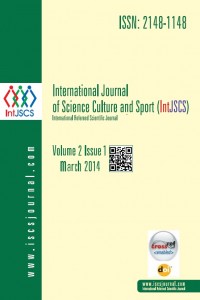Evaluation the relation between organizational structure and entrepreneurship in physical education of Islamic Azad University
Abstract
In the knowledge based economy, the most successful organizations will be those who use their organizational structure in most effective ways to improve performance. On the other hand, achieving high levels of organizational performance requires the creation and development of entrepreneurialt. This study aims to investigate the relation between organizational structure and entrepreneurship which is of discretional – correlational type , done by the field method among all the physical education ( PE ) teachers and employees of Eastern Azerbaijan, s Islamic Azad Universities (n=63) . Two questionnaires about organizational structure and entrepreneurship, whose reliability was achieved by the experts, and Pearson and T correlational coefficients, were used to test and analyze the data. The results showed no relation between organizational entrepreneurship and complexity but showed a negative and significant relation among entrepreneurship and formality and concentration. Eventually, no difference was observed between organizational entrepreneurship of the (male or female) teachers and employees.
References
- Abotorabi M (2009). Investigating the Relation between Organizational Structure and Staff Knowledge Management of Southern Khorasan’s PE Department. Fifth PE Students Gathering Mazandaran University.
- Bozbura F (2007). Participative management practices in Turkish SME, Journal of enterprise Information Management, 2(2): 209-221.
- Clark BR (1998). Creating Entrepreneurial University, Organizational pathways of University Transformation, Paris Entrepreneurial and Oxford I A U and Elsevier Science.
- Crnwall G (2002). Organization& Entrepreneurship, Mcgraw hill press.
- Daft RL (2006). The New Era of Management, India Edition, Thomson, South.
- Green MK, Covin J, Slevin DP (2008). Exploring the Relationship Between strategic Reactive-ness and Entrepreneurial Orientation: the Role of structure-style fit, Journal of Bus. Venturing, 23: 356-383.
- Green K (2007). Learning and knowledge management in corporate entrepreneurship: portfolio level determinants of launch in continuous new product development, 1-129.
- Guzman J, Cuevas F, Carrasco R (2007). Entrepreneurial strategic Qualitative Analysis: the Case of Seville (Spain), International Adv. Economics Research, 13: 488-494.
- James P (1998). Organization structure, pacific sociological review, 20(2), April.
- Nayager T, Vuuren J (2005). An analysis of an Organizational strategy, structure, culture that supports corporate Entrepreneurship in established Organization, SAJEMS, 8: 29-38.
- Neil O, Beauvais I, Gscholl R (2001). Relation between organizational culture and Organizational Structure, New York: Wiley.
- Omidi A (2008). Investigating the Relation between Organizational Structure and Entrepreneurship of PE Staff Managers. MA Thesis. Tehran University.
- Saboonchi R, Hadavi F (2010). Entrepreneurship Development Agenda, 13: 83-88, Tehran.
- Shepherd D, Covin GF, Kuratko FD (2008). Project Failure from Corporate Entrepreneurship: Managing the Grief process, Journal of Business Venturing, 1-16, (Elsevier Science Direct).
- Thompson GL (1999). The world of the Entrepreneurship; a perspective. Management Journal, 11(6).
- Wim V (2003). Entrepreneurship selection and performance, USA University of Texas at Dallas and IZA.
- Zhou CH, Etzkowitz H (2002). The Entrepreneurial University and The Future of Higher Education in China, The Scientific Basis of The Technological Era. Shenyang. Northeastern University, 1-17.
Evaluation the relation between organizational structure and entrepreneurship in physical education of Islamic Azad University
Abstract
This study aims to investigate the relation between organizational structure and
entrepreneurship which is of discretional - correlational type, done by the field method among
all the physical education (PE) teachers and employees of Eastern Azerbaijan’s Islamic Azad
Universities (n=63). Two questionnaires about organizational structure and entrepreneurship,
whose reliability was achieved by the experts, and Pearson and T correlational coefficients,
were used to test and analyze the data. The results showed no relation between organizational
entrepreneurship and complexity but showed a negative and significant relation among
entrepreneurship and formality and concentration. Eventually, no difference was observed
between organizational entrepreneurship of the (male or female) teachers and employees.
Keywords
References
- Abotorabi M (2009). Investigating the Relation between Organizational Structure and Staff Knowledge Management of Southern Khorasan’s PE Department. Fifth PE Students Gathering Mazandaran University.
- Bozbura F (2007). Participative management practices in Turkish SME, Journal of enterprise Information Management, 2(2): 209-221.
- Clark BR (1998). Creating Entrepreneurial University, Organizational pathways of University Transformation, Paris Entrepreneurial and Oxford I A U and Elsevier Science.
- Crnwall G (2002). Organization& Entrepreneurship, Mcgraw hill press.
- Daft RL (2006). The New Era of Management, India Edition, Thomson, South.
- Green MK, Covin J, Slevin DP (2008). Exploring the Relationship Between strategic Reactive-ness and Entrepreneurial Orientation: the Role of structure-style fit, Journal of Bus. Venturing, 23: 356-383.
- Green K (2007). Learning and knowledge management in corporate entrepreneurship: portfolio level determinants of launch in continuous new product development, 1-129.
- Guzman J, Cuevas F, Carrasco R (2007). Entrepreneurial strategic Qualitative Analysis: the Case of Seville (Spain), International Adv. Economics Research, 13: 488-494.
- James P (1998). Organization structure, pacific sociological review, 20(2), April.
- Nayager T, Vuuren J (2005). An analysis of an Organizational strategy, structure, culture that supports corporate Entrepreneurship in established Organization, SAJEMS, 8: 29-38.
- Neil O, Beauvais I, Gscholl R (2001). Relation between organizational culture and Organizational Structure, New York: Wiley.
- Omidi A (2008). Investigating the Relation between Organizational Structure and Entrepreneurship of PE Staff Managers. MA Thesis. Tehran University.
- Saboonchi R, Hadavi F (2010). Entrepreneurship Development Agenda, 13: 83-88, Tehran.
- Shepherd D, Covin GF, Kuratko FD (2008). Project Failure from Corporate Entrepreneurship: Managing the Grief process, Journal of Business Venturing, 1-16, (Elsevier Science Direct).
- Thompson GL (1999). The world of the Entrepreneurship; a perspective. Management Journal, 11(6).
- Wim V (2003). Entrepreneurship selection and performance, USA University of Texas at Dallas and IZA.
- Zhou CH, Etzkowitz H (2002). The Entrepreneurial University and The Future of Higher Education in China, The Scientific Basis of The Technological Era. Shenyang. Northeastern University, 1-17.
Details
| Primary Language | English |
|---|---|
| Subjects | Sports Medicine |
| Journal Section | Research Article |
| Authors | |
| Publication Date | March 16, 2014 |
| Published in Issue | Year 2014 Volume 2 - Issue 1 |

